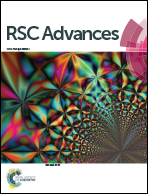Synthesis, characterization, crystal structure, cytotoxicity, apoptosis and cell cycle arrest of ruthenium(ii) complex [Ru(bpy)2(adpa)](PF6)2 (bpy = 2,2′-bipyridine, adpa = 4-(4-aminophenyl)diazenyl-N-(pyridin-2-ylmethylene)aniline)†
Abstract
A novel ruthenium(II) complex [Ru(bpy)2(adpa)](PF6)2 (bpy = 2,2′-bipyridine, adpa = 4-(4-aminophenyl)diazenyl-N-(pyridin-2-ylmethylene)aniline) (Ru-adpa) was synthesized, characterized and confirmed by X-ray diffraction studies. The cytotoxic potential of the complex was tested on AGS, BGC823 and SGC7901 cancer cells, the viability of the treated cells was evaluated by MTT assay and colony formation assay. The mode of cell death was assessed by different morphological studies of DNA damage and apoptosis assays (Hoechst staining, acridine orange & ethidium bromide (AO & EB) staining and flow cytometry assay). The Ru-adpa induced cell death in a dose- and time-dependent manner, and the mode of cell death were essentially apoptosis though necrosis was also noticed. Cell cycle analysis by flow cytometry indicated that the Ru-adpa caused cell cycle arrest and accumulated cells in the S phase. The DNA binding properties with Ru-adpa were studied by gel electrophoresis.
2 (bpy = 2,2′-bipyridine, adpa = 4-(4-aminophenyl)diazenyl-N-(pyridin-2-ylmethylene)aniline)](/en/Image/Get?imageInfo.ImageType=GA&imageInfo.ImageIdentifier.ManuscriptID=C4RA12715C&imageInfo.ImageIdentifier.Year=2015)

 Please wait while we load your content...
Please wait while we load your content...